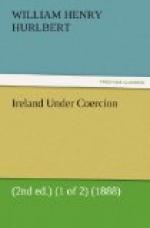Of this clause, too, I am told to-night that the scale of compensation fixed for the awards of the Court in the third section of it was devised (though Mr. Gladstone did not know this) by an Irish member in the interest of the “strong farmers,” who wish to root out the small farmers. There is an apparent confirmation of this story in the fact that under this section the small farmers, under L10, may be awarded against the landlord seven years’ rent as compensation for disturbance, while the number of years to be accounted for in the award diminishes as the rental increases, a discrimination not unlikely to strengthen the preference of the landlords for the large farm system.
CHAPTER V.
DUBLIN, Tuesday, Feb. 14th.—I left Abbeyleix this morning for Dublin, in company with Mr. and Mrs. Henry Doyle. Mr. Doyle, C.B., a brother of that inimitable master of the pencil, and most delightful of men, Richard Doyle, is the Director of the Irish National Gallery. He was kind enough to come and lunch with me at Maple’s, after which we went together to the Gallery. It occupies the upper floors of a stately and handsome building in Merrion Square, in front of which stands a statue of the founder, Mr. William Dargan, who defrayed all the expenses of the Dublin Exhibition in 1853, and declined all the honours offered to him in recognition of his public spirited liberality, save a visit paid to his wife by Queen Victoria. The collection now under Mr. Doyle’s charge was begun only in 1864, and the Government makes it an annual grant of no more than L2500, or about one-half the current price, in these days, of a fine Gainsborough or Sir Joshua! “They manage these things better in France,” was evidently the impression of a recent French tourist in Ireland, M. Daryl, whose book I picked up the other day in Paris, for after mentioning three or four of the pictures, and gravely affirming that the existence here of a gallery of Irish portraits proves the passionate devotion of Dublin to Home Rule, he dismisses the collection with the verdict that “ce ne vaut pas le diable.” Nevertheless it already contains more really good pictures than the Musee either of Lyons or of Marseilles, both of them much larger and wealthier cities than Dublin. Leaving out the Three Maries of Perugino at Marseilles, and at Lyons the Ascension, which was once the glory of San Pietro di Perugia, the Moses of Paul Veronese, and Palma Giovanni’s Flagellation, these two galleries put together cannot match Dublin with its Jan Steen, most characteristic without being coarse, its Terburg, a life-size portrait of the painter’s favourite model, a young Flemish gentleman, presented to him as a token of regard, its portrait of a Venetian personage by Giorgione, with a companion portrait by Gian Bellini, its beautiful Italian landscape by Jan Both, its flower-wreathed head of a white bull by Paul Potter, its exquisitely finished “Vocalists” by Cornells Begyn, its admirable portrait of a Dutch gentleman by Murillo, and its two excellent Jacob Ruysdaels. A good collection is making, too, of original drawings, and engravings, and a special room is devoted to modern Irish art. I wish the Corcoran Gallery (founded, too, by an Irishman!) were half as worthy of Washington, or the Metropolitan Museum one-tenth part as worthy of New York!




